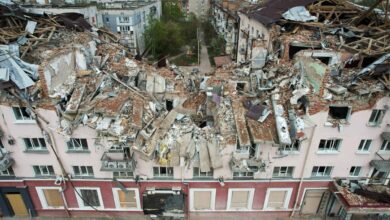Ukraine ‘could lose crops for at least 100 years due to metal pollution caused by Russian invasion’

Farmers in Ukraine could lose crops for at least 100 years due to metal pollution caused by artillery bombardments during Russia’s illegal invasion, warns new research.
The country produces much of the world’s grain supply – and has been subjected to widespread artillery damage from Russian attacks.
A new study has discovered heavy metal pollution from shelling during the Battle of the Somme more than a century later.
It has been dubbed ‘bombturbation’ – the long-term effects of explosive munitions, ranging from grenades to heavy artillery.
The phenomenon was identified in soil collected from craters on the front line in northern France.
An analysis found the dirt contains elevated levels of copper and lead – which destroys plants.
Corresponding author Dr Naomi Rintoul-Hynes, of Canterbury Christ Church University, Kent, said: “As well as the short-term impacts to agriculture through crop supply chain issues, these fields may be dangerously contaminated by munitions in the long-term – possibly for 100 years or more.”
She added: “This could impact food security not only in Ukraine, but potentially on a global scale.”
The British team focused on a small, wood in the Pas-de-Calais region. It was the scene of significant battles. Many other areas came under even more intense fire.
Dr Rintoul-Hynes said: “In Europe, the First World War has left a legacy on the environment due to the extensive and intense use of artillery during this period.
“In a process named ‘bombturbation’, significant physical changes have occurred to the landscape subject to artillery fire, resulting in a divergent soil development in craters.
“Soil heavy metal concentrations did not differ within craters compared to the flat landscape.
“However, lead and copper enrichment was observed above the baseline values for the region.”
The study site is within Sheffield Memorial Park, near the village of Puisieux – part of the British front line during 1916. It has not been relandscaped or decontaminated.
Some lead levels were above legal limits deemed safe for soils in the UK and European Union.
Dr Rintoul-Hynes added that it is likely they have had “ecotoxicological and human health effects.”
At the end of 1918, when the cannons finally fell silent, nothing remained in the area, particularly around Bapaume. Not a single tree, house or church.
Every community in the Pas-de-Calais had an involvement. All had seen their youngest inhabitants head off to war – and cried for those who had “died for France.”
French historian Professor Xavier Boniface described the Pas-de-Calais as a “microcosm of the world at war.”





